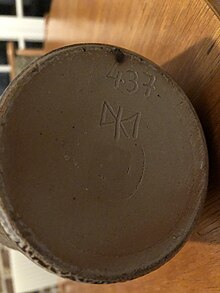Wim Mühlendyck
Wim Mühlendyck (born March 1, 1905 in Porz , † April 10, 1986 in Höhr-Grenzhausen ) was a German sculptor and ceramist .
Life
Wim Mühlendyck graduated from high school in Cologne in 1924 . From 1924 to 1925 he studied at the university there . From 1925 to 1926 he attended the Cologne factory schools and then until 1927 the State Ceramic Technical School in Höhr-Grenzhausen. From 1927 to 1930 he trained as a trade teacher in Cologne. He then worked as a vocational school teacher in Frechen . In 1931 Mühlendyck founded his own workshop in Höhr-Grenzhausen, where he built a pottery farm in 1936. In 1937 he passed the master's examination.
meaning
Wim Mühlendyck is considered to be the innovator of Westerwald ceramics. After moving from Cologne to the Westerwald, he familiarized himself with the Westerwald ceramics, immersed himself in the red and knee technique and applied this art to building ceramics, for example. Until then, this technology was mainly found on vessels, but he also used it to produce tiles and large surfaces. Examples can be found on the floors of the Protestant Christ Church in Höhr-Grenzhausen and in the cemetery chapel there. In the red and knee technique, patterns are scratched into the surface with a wood or iron. Mention is z. B. the so-called Kniebissonne and the so-called Kniebisstern. He set another focus in the manufacture of ceramic tombstones, which was unusual until then. These were also used in military cemeteries .
Awards
- 1937–39: Gold medal, Triennale Milan / Honorary Prize, World Exhibition Paris / Gold Medal, craft exhibition Berlin
- 1954: Gold medal, Milan Triennale
- 1956: Florence silver medal
- 1965: Honorary award from the DKG
gallery
Selection of works
- Town hall fountain in Frechen (1981).
- Ceramic cross in the chancel of the Christ Church in Essen .
signature
Carved or stamped, a symbol for mill wings, which is composed of the letters WIM.
| personal data | |
|---|---|
| SURNAME | Mühlendyck, Wim |
| BRIEF DESCRIPTION | German sculptor and ceramist |
| DATE OF BIRTH | March 1, 1905 |
| PLACE OF BIRTH | Porz |
| DATE OF DEATH | April 10, 1986 |
| Place of death | Höhr-Grenzhausen |


